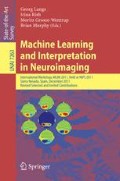Abstract
The prediction of behavioral covariates from functional MRI (fMRI) is known as brain reading. From a statistical standpoint, this challenge is a supervised learning task. The ability to predict cognitive states from new data gives a model selection criterion: prediction accuracy. While a good prediction score implies that some of the voxels used by the classifier are relevant, one cannot state that these voxels form the brain regions involved in the cognitive task. The best predictive model may have selected by chance non-informative regions, and neglected relevant regions that provide duplicate information. In this contribution, we address the support identification problem. The proposed approach relies on randomization techniques which have been proved to be consistent for support recovery. To account for the spatial correlations between voxels, our approach makes use of a spatially constrained hierarchical clustering algorithm. Results are provided on simulations and a visual experiment.
Access this chapter
Tax calculation will be finalised at checkout
Purchases are for personal use only
Preview
Unable to display preview. Download preview PDF.
References
Breiman, L.: Random forests. Machine Learning 45, 5–32 (2001)
Carroll, M.K., Cecchi, G.A., Rish, I., Garg, R., Rao, A.R.: Prediction and interpretation of distributed neural activity with sparse models. NeuroImage 44(1), 112–122 (2009)
Fan, R., Chang, K., Hsieh, C., Wang, X., Lin, C.: LIBLINEAR: A library for large linear classification. The Journal of Machine Learning Research 9, 1871–1874 (2008)
Haxby, J.V., Gobbini, I.M., Furey, M.L., Ishai, A., Schouten, J.L., Pietrini, P.: Distributed and overlapping representations of faces and objects in ventral temporal cortex. Science 293(5539), 2425–2430 (2001)
Jenatton, R., Gramfort, A., Michel, V., Obozinski, G., Eger, E., Bach, F., Thirion, B.: Multi-scale Mining of fMRI data with Hierarchical Structured Sparsity. ArXiv e-prints (May 2011)
Krishnapuram, B., Carin, L., Figueiredo, M.A., Hartemink, A.J.: Sparse multinomial logistic regression: Fast algorithms and generalization bounds. IEEE Transactions on Pattern Analysis and Machine Intelligence 27, 957–968 (2005)
Meinshausen, N., Bühlmann, P.: Stability selection. Journal of the Royal Statistical Society: Series B (Statistical Methodology) 72(4), 417–473 (2010)
Michel, V., Gramfort, A., Varoquaux, G., Eger, E., Thirion, B.: Total variation regularization for fMRI-based prediction of behavior. IEEE Transactions on Medical Imaging 30(7), 1328–1340 (2011)
Michel, V., Gramfort, A., Varoquaux, G., Eger, E., Keribin, C., Thirion, B.: A supervised clustering approach for fMRI-based inference of brain states. Pattern Recognition, epub ahead of print (April 2011)
Mitchell, T.M., Hutchinson, R., Niculescu, R.S., Pereira, F., Wang, X., Just, M., Newman, S.: Learning to decode cognitive states from brain images. Machine Learning 57(1), 145–175 (2004)
Ng, A.: Feature selection, l1 vs. l2 regularization, and rotational invariance. In: Proceedings of the Twenty-First International Conference on Machine Learning, p. 78. ACM (2004)
Pedregosa, F., Varoquaux, G., Gramfort, A., Michel, V., Thirion, B., Grisel, O., Blondel, M., Prettenhofer, P., Weiss, R., Dubourg, V., Vanderplas, J., Passos, A., Cournapeau, D., Brucher, M., Perrot, M., Duchesnay, E.: Scikit-learn: Machine learning in Python. Journal of Machine Learning Research 12, 2825–2830 (2011)
Rish, I., Cecchi, G., Heuton, K., Baliki, M., Apkarian, A.: Sparse regression analysis of task-relevant information distribution in the brain. In: SPIE Medical Imaging (2012)
Ward, J.H.: Hierarchical grouping to optimize an objective function. Journal of the American Statistical Association 58, 236 (1963)
Yamashita, O., Aki Sato, M., Yoshioka, T., Tong, F., Kamitani, Y.: Sparse estimation automatically selects voxels relevant for the decoding of fMRI activity patterns. NeuroImage 42(4), 1414–1429 (2008)
Author information
Authors and Affiliations
Editor information
Editors and Affiliations
Rights and permissions
Copyright information
© 2012 Springer-Verlag Berlin Heidelberg
About this paper
Cite this paper
Gramfort, A., Varoquaux, G., Thirion, B. (2012). Beyond Brain Reading: Randomized Sparsity and Clustering to Simultaneously Predict and Identify. In: Langs, G., Rish, I., Grosse-Wentrup, M., Murphy, B. (eds) Machine Learning and Interpretation in Neuroimaging. Lecture Notes in Computer Science(), vol 7263. Springer, Berlin, Heidelberg. https://doi.org/10.1007/978-3-642-34713-9_2
Download citation
DOI: https://doi.org/10.1007/978-3-642-34713-9_2
Publisher Name: Springer, Berlin, Heidelberg
Print ISBN: 978-3-642-34712-2
Online ISBN: 978-3-642-34713-9
eBook Packages: Computer ScienceComputer Science (R0)

